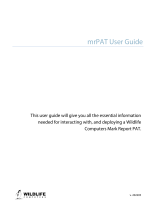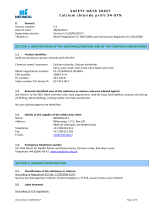Page is loading ...

v.202203
Stomach Temperature Pill
This user guide will give you all the essential information needed
for interacting with, and deploying a Wildlife Computers Stomach
Temperature Pill.

Page 2
The information contained in these documents is confidential, privileged and only for the information of the intended recipient a
nd
may not be used, published or redistributed without the prior written consent of Wildlife Computers.
Table of Contents
About the STP ..............................................................................................................................................3
How it Works................................................................................................................................................3
Operational Mode ........................................................................................................................................4
Interpreting Temperature Readings ............................................................................................................4
Understanding LED Flashes ..........................................................................................................................6
Set-up Tips and Other Advice ......................................................................................................................6
Contacting Wildlife Computers ....................................................................................................................7

Page 3
The information contained in these documents is confidential, privileged and only for the information of the intended recipient a
nd
may not be used, published or redistributed without the prior written consent of Wildlife Computers.
About the STP
The Stomach Temperature Pill (STP) is designed to give insight as to when animals feed by detecting
temperature changes associated with ingesting cold prey. The STP is inserted into, and remains
within, the stomach of a warm-blooded study animal throughout the duration of the project.
The temperature of the STP is measured using four thermistors, and the coldest measured
temperature is relayed to an associated Wildlife Computers MK10-L or MK10-AL data recorder. A
sudden drop in the measured temperature may be an indication that the study animal ingested cold
prey. The STP3 must be within approximately 2 m of the MK10-L or MK10-AL for the temperature to
be received.
The STP3 measures and transmits temperatures from 0 to 50C (with a
resolution of 0.1C, and accuracy of approximately ± 0.3C) at a user-
specified transmission interval of 10, 20, or 30 seconds. Limited battery
capacity means that messages spaced 10 seconds apart will yield
approximately 22 days of life, 20 seconds apart will yield
approximately 45 days, and 30 seconds apart will yield approximately 69 days.
The components are cast in an epoxy tube which measures 63mm in length and 21.5mm in diameter.
The temperature sensors are attached to the inside of a titanium ring to minimize the temperature
response time. The STP3 is turned on (Deployed) and off (Shutdown) with a magnet. An LED flashes in
response to confirm whether the STP3 is “on” or “off.”
How it Works
Once enabled with a magnet, the STP3 transmits encoded messages at pre-defined intervals. These
messages encode temperature over the range 0 to 50C. Temperatures below 0C will be encoded as 0C
and temperatures above 50C will be encoded as 50C.
Normally, the STP is inserted into the stomach of an animal and the encoded messages are received by
an MK10-L or MK10-AL tag mounted on the outside of the animal, no more than 2 m from the STP. The
MK10 synchronizes itself to receive the encoded messages and saves the temperatures into the data
archive. MK10-AL tags also encode the temperatures into messages that are relayed back to the
investigator by the Argos satellite system.
Ideally stomach temperature should be measured in the middle of the stomach and not against the
stomach wall, where the temperature may not be affected by ingested cold prey. Given that we cannot
be sure that the STP isn’t against the stomach wall, four temperature sensors, spaced equally around a
titanium ring, record temperature. We assume that the coldest temperature measured best reflects the
temperature in the middle of the stomach.

Page 4
The information contained in these documents is confidential, privileged and only for the information of the intended recipient a
nd
may not be used, published or redistributed without the prior written consent of Wildlife Computers.
Operational Mode
The STP3 transmits the coldest temperature reading of the four thermistors. Three ping intervals are
available (10, 20 and 30 seconds). The user will specify the ping interval for the current research project
at the time the order is placed.
Interpreting Temperature Readings
When the STP3 is used in conjunction with an MK10-AL, the MK10-AL can generate three message types
to be relayed back the user via the Argos satellite system. Some of these message types are triggered
by an “ingestion event”. An ingestion event is defined as starting with the detection of a rapid drop in
stomach temperature (ST) and ending when the ST returns to within 0.5C of pre-ingestion temperatures
or when the event exceeds a maximum duration. You preset values to fine-tune the ingestion event
detection.
Message Types
Ingestion event message
This message is created as an ingestion event finishes and contains the following parameters:
o The time and date of the ingestion event
o The ST immediately before the ingestion event started
o The first ST of the ingestion event
o The depth immediately before the ingestion event started
o Whether the tag was ascending or descending when the ingestion event started
o The deepest depth measured during the ingestion event
o The seawater temperature at this deepest depth
o The time of this deepest depth
o The overall duration of the feeding event
o The last ST of the feeding event
o The lowest ST recorded
o The time of the lowest ST recorded
Fine-scale ST message
During a recognized ingestion event, the ST readings will be saved as a time-series at 1-min intervals.
Temperature resolution is 0.1C.
Course-scale ST message
This is the default method of encoding ST readings as a time-series. Data are stored at 2-min intervals,
but small changes in temperature (< ±0.5C) will be reported as “no change”. This allows much greater
compression of data.
These message types can be selected independently. Selecting or deselecting the “ingestion events
records” just affects the generation of such messages, not the recognition of ingestion events. Thus, you
can deselect “Ingestion events records” and select “fine-scale ST...” and fine-scale messages will still be
generated during an ingestion event. The table below shows how the fine- and coarse-scale messages
interact.

Page 5
The information contained in these documents is confidential, privileged and only for the information of the intended recipient a
nd
may not be used, published or redistributed without the prior written consent of Wildlife Computers.
Fine-scale Disabled
Fine-scale Enabled
Coarse-scale disabled No time-series messages are
generated.
No time-series messages will be
generated unless an ingestion
event is underway.
Coarse-scale enabled
Coarse-scale messages will be
generated throughout the
deployment. No special action
will take place during an
ingestion event.
Coarse-scale messages will be
generated between ingestion
events, and fine-scale messages
will be generated during ingestion
events.
Ingestion event messages will always be generated if enabled, regardless of the settings for Fine- and
Coarse-scale ST messages.

Page 6
The information contained in these documents is confidential, privileged and only for the information of the intended recipient a
nd
may not be used, published or redistributed without the prior written consent of Wildlife Computers.
Understanding LED Flashes
The STP3 incorporates Wildlife Computers Smart On/Off Protocol. To toggle the tag from Deploy (on) to
Shutdown (off), and vice versa, requires two properly timed magnet swipes. After the first swipe from
the bottom of the serial number label to the bottom of the penguin label, the LED will flash indicating
the current state of the pill (Shutdown or Deploy).
• Shutdown: Two rapid blinks (75ms on, 75ms off), then off for two seconds. Two more rapid
blinks (75ms on, 75ms off), then off for two more seconds, for a total time of 6.5 seconds.
• Deploy: Ten rapid blinks (200 ms on, 50 ms off) for a total of 2.5 seconds.
After current state flash sequence, the LED will be on solid for two seconds. During this period a second
magnet swipe from the bottom of the serial number label to the bottom of the penguin label will
toggle the state of the STP3. If you keep the magnet away from the STP3 during this long LED flash, the
STP3 will stay in its current mode. If the state has been toggled during the long LED flash, the blinking
sequence will start over.
LED Flash Sequence
Once the pill is Deployed, the LED will flash for the first 50 messages. A single short LED flash indicates
that all is operating as it should. Any other flash sequence, e.g., a double short flash or no flash at all,
indicates there is a problem with the pill and it should not be deployed in an animal. If the LED has
ceased flashing after the 50 messages, a single swipe with the magnet will reset the internal counter
and LED will flash for 50 more messages.
Set-up Tips and Other Advice
• You can test the functionality of the STP3 when the MK10-L or MK10-AL is connected to
MK10Host. More details are provided in the MK10 Manual.
• In Shutdown mode, the STP3 can be stored for years. For long storage, the STP3 should be kept
in a cool environment, preferably at +5 C° in a refrigerator or in a non-commercial freezer, to
help prevent battery passivation.
• Other researchers have found that the animal may regurgitate objects if too large or pass them
if too small. We were unable to make these “pills” any smaller. If, however, you feel the pill is
too small and want to add more epoxy or other inert material, ensure that the metal ring is still
exposed.

Page 7
The information contained in these documents is confidential, privileged and only for the information of the intended recipient a
nd
may not be used, published or redistributed without the prior written consent of Wildlife Computers.
Contacting Wildlife Computers
U.S. and International
Members of the Wildlife Computers technical sales and support team are located in Redmond, WA,
USA, and Havelock North, New Zealand, allowing us to cover promptly a wide range of time zones.
Mailing and Shipping
Wildlife Computers 8310
154th Avenue NE, Suite 150
Redmond, WA 98052 USA
Email
Sales, Quotes, and Inquiries: tags@wildlifecomputers.com
Technical Support: support@wildlifecomputers.com
Phone Website
+1 (425) 881 3048 WildlifeComputers.com
For Asian Clients
While we welcome your direct correspondence, we recommend that you contact our colleague, Yong
Huang, for assistance. Mr. Huang understands the special purchase processes for your countries, and
will provide you with the best service for the best price. He also is fluent in Japanese, Chinese, and
English.
Mailing Address—Please ship tags to our main office in Redmond, WA.
Yong Huang
Enfotran Corporation
816 Evergreen Point Road, #217
Medina, WA 98039 USA
Email Phone Fax
[email protected] +1 (425) 456 0101 +1 (425) 456 0303
/




